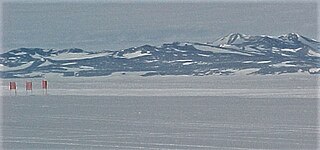Sky Blu may refer to:
- Sky Blu (Antarctica), a British Antarctic Survey forward operating station in Antarctica
- Sky Blu (rapper) (born 1986), American rapper
Sky Blu may refer to:
Wishbone commonly refers to Furcula, a fork-shaped bone in birds and some dinosaurs
The sky is the area above the Earth as seen from the ground.
Mendel may refer to:

The Rothera Research Station is a British Antarctic Survey (BAS) base on the Antarctic Peninsula, located at Rothera Point, Adelaide Island. Rothera also serves as the capital of the British Antarctic Territory, a British Overseas Territory.

A blue ice runway is a runway constructed in Antarctic areas with no net annual snow accumulation. The density of the ice increases as air bubbles are forced out, strengthening the resultant ice surface so that aircraft landings using wheels instead of skis can be supported. Such runways simplify the transfer of materials to research stations, since wheeled aircraft can carry much heavier loads than ski-equipped aircraft.

Pulse is a concert video by Pink Floyd of their 20 October 1994 concert at Earls Court, London during The Division Bell Tour. It was originally released on VHS and Laserdisc in June 1995, with a DVD release coming in July 2006, with the latter release containing numerous bonus features.

Sky Blu is a forward operating station for the British Antarctic Survey located in southern Palmer Land, Antarctica. It is in an area of blue ice, an extremely hard and dense ice which has lost the air bubbles that normally cloud the ice. It provides a runway able to accommodate wheeled aircraft that are larger than can be handled by other types of runways in the area.
The British Antarctic Survey (BAS) is the United Kingdom's national polar research institute. It has a dual purpose, to conduct polar science, enabling better understanding of global issues, and to provide an active presence in the Antarctic on behalf of the UK. It is part of the Natural Environment Research Council (NERC). With over 400 staff, BAS takes an active role in Antarctic affairs, operating five research stations, one ship and five aircraft in both polar regions, as well as addressing key global and regional issues. This involves joint research projects with over 40 UK universities and more than 120 national and international collaborations.
Blu or BLU may refer to:

Johnson Barnes III, better known by his stage name Blu, is an American rapper and record producer from Los Angeles, California. He performs as one half of the duo Blu & Exile, which was formed in 2007 and whom released their debut studio album, Below the Heavens in July of that year. He is also the forefront member of the California-based collective, Dirty Science. He is recognized for his collaborative albums with record producers Mainframe, Ta'Raach, Bombay, Damu the Fudgemunk, Madlib, Nottz, and Union Analogtronics. Since his debut, he has had a productive standard of releasing multiple albums.

LMFAO was an American electronic dance music duo consisting of Redfoo and Sky Blu. Redfoo is the youngest son of Motown Records founder Berry Gordy and Nancy Leiviska. Sky Blu is Gordy's grandson and the son of Redfoo's half-brother, Berry Gordy IV, Gordy's son with his first wife Thelma Coleman.
Many research stations in Antarctica support satellite field camps which are, in general, seasonal camps. The type of field camp can vary – some are permanent structures used during the annual Antarctic summer, whereas others are little more than tents used to support short term activities. Field camps are used for many things, from logistics to dedicated scientific research.

"La La La" is a song performed by American electro recording duo LMFAO. It was released as the second single from their debut studio album Party Rock (2009) and first sent to airplay on September 8, 2009.

Skyler Austen Gordy, better known by his stage name Sky Blu, is an American rapper, singer, songwriter, record producer, DJ, and dancer. He is known as part of the EDM-hip house duo LMFAO, which he formed with his half-uncle and fellow rapper Redfoo in 2006. The duo are best known for their 2011 singles "Party Rock Anthem" and "Sexy and I Know It," both of which peaked atop the Billboard Hot 100. They released two studio albums: Party Rock (2009) and Sorry for Party Rocking (2011) through will.i.am Music Group, an imprint of Interscope Records until their disbandment in 2012. As a solo act, Gordy has released the albums Rebel Music (2013) and Fxck Yeah: Chaos To Consciousness (2016).
"The Last Day" is a mini-episode of the British science fiction television programme Doctor Who. It was made available on BBC iPlayer and YouTube on 21 November 2013, as part of the BBC One lead-up to the show's 50th anniversary special.
Salud may refer to:

Rothera Air Facility is an airfield serving Rothera Research Station, the British Antarctic Survey logistics centre for the Antarctic and home of well-equipped biological laboratories and facilities for a wide range of research. The station is situated on a rock and raised beach promontory at the southern extremity of Wormald Ice Piedmont, south-eastern Adelaide Island.

Kimetrius Christopher Foose, known by his stage name Lil Skies, is an American rapper and singer-songwriter from Waynesboro, Pennsylvania. He signed with Atlantic Records in 2017 to release the hit singles "I", "Nowadays", and "Red Roses." The songs peaked at numbers 39, 55, and 69 respectively on the Billboard Hot 100. His major label debut mixtape, Life of a Dark Rose (2018) peaked at number ten on the Billboard 200 chart and received platinum certification by the Recording Industry Association of America (RIAA). His debut studio album Shelby (2019) and its follow up Unbothered (2021) followed thereafter, peaking respectively at numbers five and 50 on the chart.
"Sick" Rick Armstrong is a professional skier, freeskiing pioneer, mountaineer, paraglider, businessman and serial entrepreneur based in Jackson Hole, Wyoming. He was a pioneering guide in the early years of Alaska Heli-skiing while working as a lead guide for Valdez Heli-skiing and Doug Coombs as chronicled in the 2007 feature film Steep. He was a member of the ultra-elite group of skiers called the Jackson Hole Airforce who transformed skiing in the 1990s and 2000s. He is known for having skied unskied lines such as his first and unrepeated massive drop into the left side of the notorious Corbet's Couloir at Jackson Hole Mountain Resort. He was the first person to have both skied and snowboarded the Grand Teton in Teton National Park. He has many first ski descents in China, Alaska, Europe, Antarctica, South America, and South Georgia Island. He was an athlete in the 1998 and 1999 Winter X-Games in Crested Butte. He was Awarded sponsorships by The North Face and Salomon. He also became an athlete talent scout for The North Face building a world-class ski team by discovering soon to be ski stars such as Sage-Cattabriga-Alosa, Ingrid Backstrom, Kitt Deslauries, Griffen Post, and Hillary Nelson. Armstrong was also a co-founder of the Teton Gravity Research film production company. He served on the board of directors for Intrawest from 2012 to 2017.
Sky blue is the name of a colour.